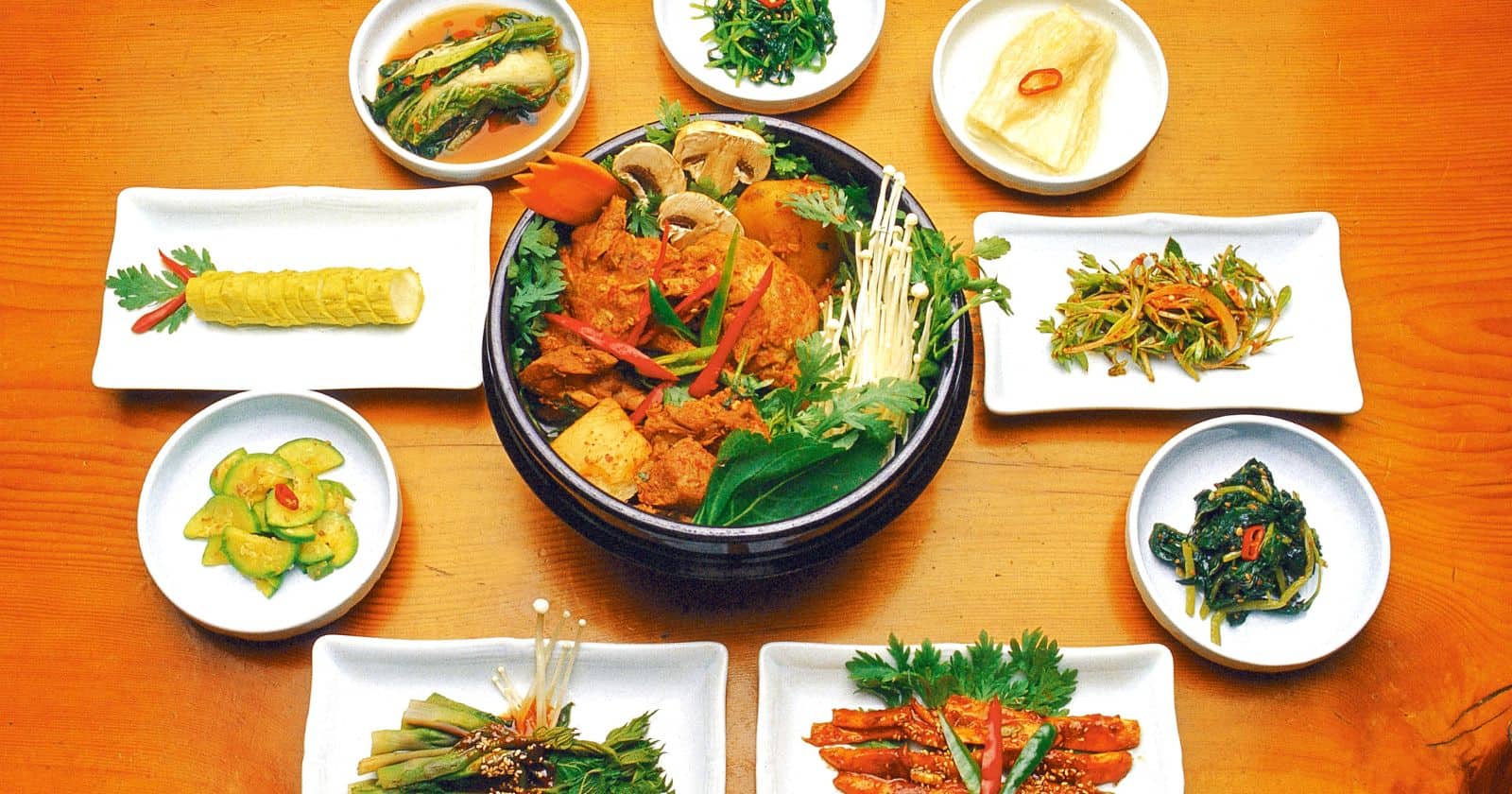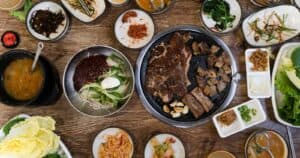Curious about the calorie content of your favorite Korean dishes? We’ve got you covered! From the refreshing and low-calorie Cucumber Kimchi to the more indulgent Kimbap and Tteokbokki, we’ll break down the numbers for you.
Whether you’re counting calories for weight management or simply want to make healthier choices, understanding the calorie content of Korean food can be a game-changer.
So, whether you’re a fan of Dak bulgogi or eager to try out some new Korean recipes, get ready to learn how to make informed choices when it comes to the calories in Korean food. Let’s dive into the delicious and nutritious world of Korean cuisine, one calorie count at a time!
Understanding the Importance of Calorie Awareness in Korean Food
Calorie awareness is crucial when it comes to enjoying Korean food while maintaining a healthy diet. While this cuisine can offer a wide variety of healthy, low-calorie options, it’s important to be mindful of dishes that may be high in calories and fat. By understanding the calorie content of specific dishes and choosing healthier alternatives, we can make informed choices when indulging in Korean cuisine.
Healthy Low-Calorie Options:
- Korean food can be a healthy choice, with its own unique style and flavors.
- However, some dishes may have high calories and fat content, making it important to learn to choose healthy options.
- Checking the calorie chart of Korean dishes can help us make informed choices and enjoy the cuisine while maintaining a balanced diet.
Wide Variety of Protein-Based Dishes:
- Korean cuisine offers a wide variety of protein-based dishes, which are generally healthier options.
- The usage of low-calorie condiments like soy sauce adds flavor without adding extra calories, and Korean food typically avoids using excessive oil.
- With the right strategies, Korean food can be a great choice for weight loss or maintaining a healthy lifestyle.
Nutritional Information:
- Online databases provide nutritional information for Korean food, allowing us to understand the calorie content of specific dishes.
- By referring to these resources, we can make educated decisions about our food choices and be aware of the calorie intake in Korean cuisine.
Exploring Low-Calorie Korean Options
Kimchi:
- Traditional Korean side dish made of fermented vegetables
- Low in calories, rich in vitamins, minerals, and probiotics
- Can be enjoyed as a standalone dish or added to other meals for added flavor and health benefits
Tofu Soup (Soon Tofu):
- Popular Korean dish made with soft tofu, vegetables, mushrooms, and seafood
- Low in calories and a nutritious option
- Provides a good source of protein and can be customized with additional vegetables and lean proteins
Bibimbap:
- Mixed rice dish with various vegetables, meat, and a spicy sauce
- Can be made with lean proteins and lots of vegetables for a healthy and satisfying choice
- Provides a good balance of carbohydrates, proteins, and fats, while being low in calories
Japchae:
- Stir-fried dish made with glass noodles, vegetables, and sometimes meat
- Typically low in calories and can be packed with vegetables for added nutrition
- Offers a good source of fiber and can be customized with different vegetables and proteins
Grilled or Steamed Fish:
- Korean cuisine includes a variety of grilled or steamed fish dishes
- Generally low in calories and high in protein
- Provides essential nutrients like omega-3 fatty acids and can be a healthy choice for calorie reduction
Seaweed Soup (Miyeokguk):
- Traditional Korean soup made with seaweed, broth, and sometimes beef or seafood
- Low in calories and a good source of vitamins and minerals
- Provides a flavor-packed and nutritious option for those seeking low-calorie Korean choices
Vegetable Pancakes (Jeon):
- Savory Korean pancakes made with various vegetables
- Lighter option compared to other fried foods
- Can be enjoyed as a side dish or a main course and provides a good source of fiber and nutrients
Popular Korean Dishes and their Calorie Counts
Kimchi:
- Low in calories
- Rich in vitamins, minerals, and probiotics
- Made of fermented vegetables like cabbage or radishes
Tteokbokki:
- Popular Korean street food
- Made with rice cakes and spicy sauce
- Around 343 calories per serving
Galbi (Korean BBQ Short Ribs):
- Korean BBQ dish made with beef short ribs
- Around 400-500 calories per serving
- Popular and flavorful choice
Japchae:
- Stir-fried dish with glass noodles, vegetables, and sometimes meat
- Typically low in calories
- Can be packed with vegetables for added nutrition
Bibimbap:
- Mixed rice dish with various vegetables, meat, and a spicy sauce
- Can be made with lean proteins and lots of vegetables
- Healthy and satisfying choice
Abalone Porridge (Jeonbokjuk):
- Korean rice porridge made with abalone
- Low in carbs and a healthy option
Grilled Eel:
- Popular Korean dish
- Contains 201 calories, 20 grams of protein, and 13 grams of fat per serving
The Health Benefits of Korean Cuisine
Korean cuisine offers a wide range of health benefits. It is balanced and nutritious, low in saturated fat, and incorporates healthy cooking methods. The emphasis on vegetables and limited use of dairy are also beneficial. The incorporation of fermented foods and health-promoting ingredients further enhance the nutritional value of Korean dishes.
Korean cuisine is known for its balance of vegetables, rice, and meat or fish. This balanced combination provides a variety of nutrients and promotes overall health. Additionally, the inclusion of small side dishes, broth-based soups, and fermented foods like kimchi adds flavor and nutritional value to meals.
When it comes to fat content, Korean cuisine often uses lean meats like chicken breast and fatty fishes, which are lower in saturated fat compared to other types of meat. This helps reduce the risk of cardiovascular diseases and promotes heart health.
Traditional Korean cooking methods, such as grilling, stir-frying, stewing, and fermenting, preserve the natural flavors and nutrients of the ingredients. This ensures that the dishes remain healthy and nutritious.
Fermented foods are a staple in Korean cuisine. Popular examples include kimchi, which is rich in probiotics. Probiotics promote gut health and digestion, contributing to a healthy digestive system.
Vegetables play a significant role in Korean cuisine, both cooked and raw. They are often served as side dishes, providing a good source of vitamins, minerals, and fiber. The wide variety of vegetables used in Korean dishes ensures a diversity of nutrients.
Unlike many other cuisines, traditional Korean cuisine is largely dairy-free. This can be beneficial for those with lactose intolerance or dairy sensitivities. By avoiding dairy, Korean dishes offer alternative sources of calcium and nutrients.
The health benefits of Korean cuisine are also attributed to the use of ingredients such as garlic, ginger, sesame oil, and soy sauce. These ingredients have been associated with various health benefits, including immune system support and reduced inflammation.
Potential Pitfalls of High-Calorie Korean Food
Korean cuisine is generally known for its healthy and flavorful dishes. However, there are some potential pitfalls when it comes to high-calorie Korean food. These pitfalls include:
High-Calorie Beverages: The modern Korean diet often includes high-calorie beverages, such as sugary soft drinks and alcoholic beverages, which can contribute to weight gain and other health issues. It’s important to be mindful of the calorie content of these drinks and opt for healthier alternatives like water or unsweetened tea.
Some Dishes are High in Calories: While Korean cuisine offers a wide variety of nutritious options, some dishes can be high in calories and fat. It’s essential to be aware of portion sizes and balance your overall calorie intake when enjoying Korean food. Opting for lighter options like grilled or steamed dishes and incorporating plenty of vegetables can help keep the calorie count in check.
Pickled and Fermented Foods: While fermented foods like kimchi can have health benefits, some pickled and fermented foods may contain high levels of sodium. This can be problematic for individuals with high blood pressure or other health issues. It’s advisable to consume these foods in moderation or choose low-sodium options when available.
Cooking Methods: Traditional Korean cooking techniques like grilling, stir-frying, stewing, and fermenting are generally healthy. However, some dishes may be prepared using less healthy methods like deep-frying, which can significantly increase their calorie content and fat content. Be mindful of the cooking methods used for your favorite Korean dishes.
High Sodium Content: Some Korean dishes, especially those that are heavily seasoned or contain soy sauce and other condiments, can be high in sodium. Excessive sodium intake can contribute to high blood pressure and other health issues. It’s essential to be mindful of your sodium intake and balance it with healthier choices throughout the day.
Navigating the World of Korean Fried Chicken
Korean fried chicken is a delicious dish known for its crispy exterior and flavorful sauce. Here are some tips to help you enjoy this popular dish while being mindful of its calorie content:
Double Frying Technique: Korean fried chicken is typically double-fried to achieve the perfect crunch. The first fry is done at a lower temperature to render out the fat, while the second fry at a higher temperature creates a crispy texture.
Sauces and Seasonings: Korean fried chicken can be served with various sauces like soy garlic or spicy sauce. These sauces can be homemade or store-bought. Remember to check the labels for the sauce’s sugar and calorie content if you’re watching your intake. When seasoning your chicken, use salt and spices to add flavor without adding unnecessary calories.
Moderation and Balance: While Korean fried chicken is delicious, it’s important to enjoy it in moderation and balance it with other healthy food choices. It is typically high in calories and fat, so be mindful of portion sizes and try to incorporate lighter options alongside it. Adding a side salad or steamed vegetables can help create a more balanced meal.
Remember, navigating the world of Korean fried chicken is about indulging in the flavors while also being mindful of your health. By following these tips, you can enjoy this popular dish while maintaining a balanced diet.
Tips for Making Healthier Choices in Korean Restaurants
Interested in making healthier choices in Korean restaurants? Here are some tips that can guide you towards a nutritious and delicious meal.
Choose Grilled or Steamed Dishes:
- Opt for grilled or steamed options as they are generally healthier compared to fried dishes.
- Grilled meats like bulgogi or galbi and steamed dishes like fish or tofu are great choices.
- These cooking methods retain more nutrients and are lower in unhealthy fats.
Look for Lean Proteins:
- Korean cuisine offers lean protein options such as chicken breast, lean beef, and seafood.
- These protein choices are lower in saturated fats, making them healthier for your heart and overall well-being.
- Enjoy dishes with lean proteins to ensure a balanced meal.
Load Up on Vegetables:
- Korean cuisine is rich in a variety of vegetables, both cooked and raw.
- Fill your plate with vegetable side dishes (banchan) and include dishes like bibimbap or japchae that incorporate vegetables.
- Vegetables are packed with essential vitamins, minerals, and fiber, making them excellent choices for a nutritious meal.
Be Mindful of Sauces and Condiments:
- Some Korean sauces and condiments, like BBQ sauces or soy-based sauces, can be high in sodium and sugar.
- Use these sauces sparingly or ask for them on the side to control your intake.
- Being mindful of the amount of sauce you consume can help in maintaining a balanced, healthier meal.
Watch Portion Sizes:
- Korean restaurants often serve food family-style with larger portions meant for sharing.
- Be mindful of portion sizes and avoid overeating.
- Moderation is key to enjoying a delicious meal while maintaining a healthy diet.
Limit Fried Foods:
- While Korean fried chicken and other fried dishes are tasty, they tend to be higher in calories and fat.
- Limit your consumption of fried foods and opt for healthier cooking methods like grilling or steaming.
- By choosing healthier cooking methods, you can reduce your calorie and fat intake.
How to Incorporate Korean Cuisine Into a Balanced Diet
Incorporating Korean cuisine into a balanced diet is a delicious and healthy way to add variety to your meals. Here are some tips for incorporating Korean cuisine into a balanced diet:
Base your meals on rice and vegetables: Korean cuisine is known for its emphasis on rice and vegetables. Make these the foundation of your meals, aiming for whole grain rice for added fiber and nutrients.
Include lean proteins: Korean cuisine offers lean protein options such as chicken breast, lean beef, and seafood. Incorporate these into your meals to provide essential nutrients while keeping saturated fat intake in check.
Embrace fermented foods: Korean cuisine is famous for its fermented foods like kimchi, which are rich in probiotics and can support gut health. Include these foods as a side dish or incorporate them into recipes to enjoy their health benefits.
Choose healthy cooking methods: Korean cooking methods like grilling, stewing, and fermenting are generally healthy. These methods help retain nutrients and minimize the need for excessive oil or added fats.
Be mindful of sodium intake: Some Korean dishes, especially those with sauces or pickled ingredients, can be high in sodium. Be mindful of your overall sodium intake and balance it with lower-sodium choices.
Control portion sizes: Korean meals often include multiple side dishes (banchan) and can be served family-style. Be mindful of portion sizes and avoid overeating. Focus on the quality of the food rather than quantity.
Limit fried and high-calorie options: While Korean cuisine offers delicious fried dishes like Korean fried chicken, these should be enjoyed in moderation due to their higher calorie and fat content. Opt for healthier cooking methods like grilling or steaming.
Stay hydrated: Korean cuisine often includes spicy flavors. Stay hydrated by drinking water or unsweetened beverages to balance the heat and maintain overall hydration.
Remember, balance and moderation are key when incorporating any cuisine into a balanced diet. By following these tips, you can enjoy the flavors and variety of Korean cuisine while making mindful choices that support your overall health and well-being.





